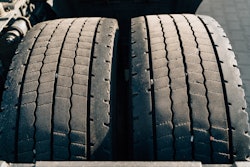Depending on the provider and lubricant used (both type and amount), an engine oil and filter change can cost upwards of $500. For fleets doing in-house service, it might be $250 in supplies, but there's the consideration of downtime.
As fleets upgrade trucks, Chevron Senior Staff Engineer Shawn Whitacre said maintenance practices deployed on the older assets are in many cases simply carried over to newer models that are coming with longer service intervals from the factory, so carriers draining around 25,000 miles – a long-standing benchmark – could be spending countless hours and thousands of dollars per year on fluid changes that might not even be necessary.
"Old habits die hard," he said. "Engine builders and oil companies alike have worked hard over the last many years to deliver on improvements that have greatly extended oil life and allowed for longer maintenance intervals."
Larger sumps, better temperature management and better control of combustion enabled by improved cylinder designs "really enhance the way the engine treats the oil," Whitacre said. "At the same time, we've done a lot to enhance oil chemistry through better soot resistance and, even more recently, through enhancing the oxidative stability of the oil – really enhancing and fortifying the additive protection that allows it to withstand higher temperatures and last longer in the engine."
[Related: More profitably with the right engine oil]
Newer model on-highway engines are equipped with OEM recommended drain intervals, depending on duty cycle, of between 60,000 and 75,000 miles, and can reach upwards of 100,000 miles based on the truck's ability to meet various conditions.
Mobil Commercial Vehicle Lubricants Applications Engineer Paul Cigala noted that small and medium fleets tend to be especially conservative when it comes to oil drain intervals, and leery of longer OEM endorsed extensions that they view as a way to sell maintenance services.
"Harder working engines – engines that get lower MPGs because they are burning more fuel – often qualify for a shorter drain interval than those that may be operating in a more steady state fashion, getting very high mpg," Whitacre said. "In those cases, the engine is not working as hard, not stressing the oil as much, and therefore the recommended drain interval can be significantly longer."
Cigala pointed to idle time as "a killer for engine oil life," in that it accelerates contamination and oxidation. In year's past, he said lube reps would ask for a fleet's miles-per-gallon and idle time to see if the company was a candidate for extended intervals, but the advent of modern telematics has refined that process as it allows fleets to pinpoint idle time, which Cigala said is often significantly higher than fleet managers think. "They used to tell us it was less than 20%, but now you can look at the ECM data and see it might really be 40% idle time," he said.
Carriers who routinely max out the OEM allowance for engine oil drains could still be leaving money on the table because Whitacre said the engine manufacturer may be willing to go further depending on the fleet's maintenance practices.
"It's really an important thing to then engage with your equipment builder – maybe your oil supplier – so that you can partner with them to put together a strategy that will allow you to comfortably and responsibly go to an extension," Whitacre said, noting many OEMs already have programs in place that define how to participate in extended drain plans. "They'll examine your duty cycle, examine your maintenance habits, as well as look at oil analysis, to make a judgement on what is actually appropriate for your specific operation."
Shell Global Solutions' OEM Technical Manager Karin Haumann noted that an engine oil analysis program can help establish proper oil drain intervals. "Optimally, you should have a sample of used oil analyzed after every oil change for every truck," Haumann said. "Closely examining the characteristics of the oil regularly can tell you a lot about both the health of the oil as well as indicate mechanical issues with an engine. This can help spot any problems with an engine early on and save on downtime and expensive repairs."
Darryl Purificati, OEM technical liaison at HollyFrontier Lubricants & Specialties, which includes the Petro-Canada Lubricants brand, said extending oil drains can only be accomplished by carefully monitoring the overall health of the engine by means of a comprehensive used oil analysis program.
"Extending oil drain intervals is unique to the condition and operation of each fleet and their used oil analysis data, so depending on these factors always check with the OEM to determine what API category oils are recommended for the engine and seek the advice of a lubricant technical advisor, who can help determine what is best for your fleet," he said.
It's better to get the OEM involved at the beginning of these studies than to bring the data to them after, Cigala said, noting the manufacturers best understand their hardware and duty cycle, "and can set some realistic goals."
Cigala cautioned fleets hoping to make an oil drain interval mileage gain with an aftermarket additive to first consult with their owner's manual because in most cases, there's no grey area in what can void an engine warranty. "It's black and white in any engine maintenance manual," he said. "It will void the warranty."
Additionally, off-the-shelf additives that contain zinc and phosphorus can be harmful to the aftertreatment system, and thickeners can inhibit oil flow, he said.
"Each oil is formulated precisely, so adding anything to the oil will dilute the carefully engineered additive package which includes detergents, dispersants and antioxidants," Haumann added. "Additional additives can actually cause harm by altering the chemical balance built into the oil and can even change the viscosity of the oil."
Carriers eyeing a drain extension also need to consider other maintenance that is performed during an oil service, and whether or not those maintenance items can wait as well, or if the PM schedule needs to be re-planned.
"It's great if I have a customer who can take their engine oil out to 90,000 miles," Cigala said, "but if it doesn't match up with their other services, they're not going to bring in the truck just for an oil change."
Haumann said there are circumstances where it may be more cost effective to change the oil at a shorter interval if a fleet is able to combine the oil change with other scheduled maintenance, thereby reducing the number of times a truck is taken out of service for planned maintenance.
OEMs typically allow lower viscosity oils in their engines, primarily using API CK-4 oils in engines newer than 2010, Purificati said, adding that engines newer than 2017 may also be approved by the OEM to run API FA-4 SAE 10W-30 or 5W-30. Fleets historically are reluctant to change oil type, especially considering the higher price point associated with the full synthetic oils that often enable the longest drain intervals, but Cigala said a change in lube type or weight might not be necessary to reap meaningful benefit.
"There are options. There are semi-synthetics. There are more premium conventional oils," he said. "All oil manufacturers have good, better, best, and somewhere in between options that will fit the bill of what [the fleet is] trying to accomplish."











